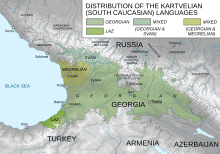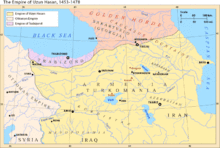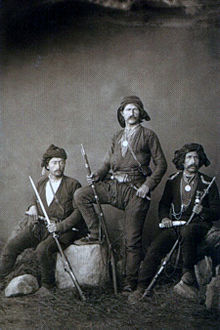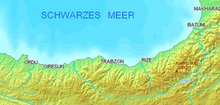Read
The hydrolases or Lazen ( Laz Lazepe / ლაზეფე ; Turkish Lazlar ; Georgian Lasebi / ლაზები ) are with the Mingreliern related südkaukasisches people that at the southeastern Black Sea coast located. The Lasen speak Lasic and, in contrast to the Christian Mingrelians, are predominantly Sunni Muslims of the Hanafi school of law. Sometimes all inhabitants of the eastern Black Sea coast are mistakenly referred to as Lasen.
population
As members of other ethnic groups ( Abkhazians , Armenians / Hemşinli , Georgians , Pontic Greeks and Turks ) live in Lasistan and many Lasen also live outside of their traditional settlement area, the exact number of Lasen on Turkish territory can only be guessed at. The UNHCR estimates that there are between 750,000 and 1.5 million members of the ethnic group.
- Feurstein (1983) speaks of 250,000 lasers,
- Andrews (1989) speaks of 45,000 lasers,
- Holisky (1991) speaks of up to half a million lasers in several estimates.
In 1926 there were 643 Lasas in the Soviet Union . Today a little more than 30,000 Lasas live in the successor states of the Soviet Union , especially in Adjara ( Georgia ).
The number of lasers living in the European Union is estimated at 5,000 to 50,000. The number of Lasen living in the EU member states is not officially recorded, since official statistics differentiate foreigners solely according to their nationality . Lasen are mostly Turkish citizens or they have been naturalized. Most of them are based in Germany . You came as guest workers in the 1970s and are now the third generation to live there.
Lasic language

The Lasic language ( Lasish : Lazuri , Turkish: Lazca ), like Georgian, belongs to the South Caucasian language family . These languages are characterized by a very complex sound system with an immense wealth of different consonants.
Although the Lasen are not ethnically related to the Turks, they are not recognized as an ethnic minority in today's Turkey. Therefore, little is known about the Lasen and their language inside and outside Turkey. Likewise, there are no reliable Turkish statistics on ethnicity, because in Turkish vernacular all people who live in the eastern Black Sea region are referred to as Laz , regardless of ethnicity . This leads to the erroneous assumption that Lasic is simply a Turkish dialect.
The number of Lasisch speakers has been falling sharply for some time. There is a risk that the Lasic language will die out after several generations. Many older Lazen still speak their language, but their children and grandchildren only speak Turkish.
Lasian cuisine and culture
One of the most popular dishes among the Lasa is the cheese dish muhlama (Turkish: kuymak ), which is traditionally prepared with the cheese minci .
Lasian music is neither learned music nor folk music, but combines both in one. It is passionate music that tells a lot about love. The main musical instrument of the Lasic folklore is the bagpipe tulum (las .: guda ). Another popular musical instrument is the box- neck lute kemençe (las .: çemane ). The music of the Lasen is now divided into two geographical parts, Georgia ( Caucasus ) and Turkey (eastern Black Sea region ). One of the most famous contemporary musicians was the singer Kâzım Koyuncu, who died of cancer in 2005 .
Settlement area
The settlement area of the Lasen lies in the southwest of Georgia and the northeast of Turkey. The inhabitants of the districts of Arhavi (read: Ark'abi ), Borçka (read: Borçxa ) and Hopa (read: Xopa ) are part of the Artvin Province , while Ardeşen (read: Art'ašeni ), Çamlıhemşin (read .: Vijadibi ), Fındıklı (las .: Vic'e ) and Pazar (las .: Atina ) are part of the province of Rize , predominantly from Las Vegas . In Georgia only a few members of this ethnic group live in the village of Sarp'i (approx. 3000) south of Batumi . Smaller groups live in the Georgian Autonomous Republic of Adjara . The region can roughly be classified geographically between the cities of Batumi (Georgia) and Rize (Turkey). This region is often referred to as Lasistan .
Because of the Russo-Ottoman War , many Lasen were expelled from their homeland to the northwestern Turkish provinces of Düzce , Kocaeli , Sakarya and Yalova . They have still lived there for generations and are large minorities in the provinces.
There are also small minorities in the neighboring provinces of Erzurum and Trabzon . There are also notable minorities in the metropolises of Ankara , Istanbul and Izmir . In the urban diaspora, the pressure to assimilate accelerates the loss of the mother tongue.
The narrow coastal strip on the Black Sea north of the Pontic Mountains rises quickly to the height of 3932 m of the Kaçkar Dağı . The very original landscape has many glaciers , lakes, forests and hot springs. The climate in the evergreen subtropical areas is mild and characterized by a lot of precipitation and high humidity.
The rivers are all short mountain streams, the ridge of the coastal chain is 20 km from the sea. The coast is rich in nut and fruit trees, as well as tea bushes. The coastal strip appears to be the home of fruit, namely grapes, cherries, pears, apples and kiwis (the latter were only introduced not so long ago). Around 150,000 Turkish and Georgian citizens of Lasi origin live in the Lasistan region, and their Lasian language is threatened with extinction.
economy
In addition to the tea producers , only the armaments company Asilsan is worth mentioning. Thanks to the oil discoveries, however, the business location could change fundamentally in the coming years. According to the Turkish daily Zaman , the region, which is characterized by a lot of precipitation, is to become a preferred vacation spot for tourists from the Arab world. In addition, the kiwi fruit is becoming increasingly important for the region.
In the past, the Lasa practiced subsistence farming : growing corn , tobacco , rice , hazelnuts , and fruit . However, economic hardship often forced the men to take work outside of their settlement areas in Transcaucasia and in the west of the Ottoman Empire.
In the past 50 years, tea cultivation has changed the economy and the landscape in Lasistan. Tea is the basis of life and the basis of a relative prosperity for the Lasen. Every possible free space in the valleys is used and terraces with knee to waist-high tea bushes pull up the mountain slopes. Numerous smaller factories in the surrounding villages process the tea, which is Lasistan's most important export.
The Lasen attach great importance to the education of their children. Because many trained Lasers work as civil servants, they live all over Turkey. For the most part, however, they have close ties to their original settlement area. Many of these Lasen return to their home villages in the summer, visit relatives and help with the labor-intensive tea harvest.
history
The Lasen have their roots in ancient Colchis . The legend about Jason and his Argonauts provides certain mythical details.
In the early Middle Ages (6th century) the kingdom of Lasika (Lasica), in the Black Sea area on today's Georgian-Turkish border, played no insignificant role in the disputes between Eastern Roman Byzantium and Persia , as it was considered an important front wall. In the 6th century (other sources say the 10th century) the area became predominantly Christian under the Eastern Roman Empire.
In the 8th century Egrisi split off from the regional association, which was to develop into the ruling power in Georgia. In the 10th century the Lasen were incorporated into the Georgian Kingdom.

Eight years after the capture of Constantinople in 1461, the Ottoman Sultan Mehmed II conquered the Trapezunt empire , with which the Lasen came under Turkish rule for the first time .
In the late 15th century the majority of the Lasen gave up the Georgian Orthodox faith and ascribed themselves to Islam . In the Ottoman Empire , the Sanjak Lazistan with the capital Rize existed in the province of Trabzon .
In the Peace of San Stefano (March 3, 1878) and at the Berlin Congress , the Ottomans ceded parts of Lasistan to Russia after a lost war . The 1920 peace treaty of Sèvres agreed with the Ottoman Empire granted Georgia control of eastern Lasistan. However, it was never implemented by the Turks under the leadership of Mustafa Kemal (Ataturk) and was later revised in the Treaty of Lausanne in favor of the newly formed Turkey .
In 1921, after the Turkish-Russian agreement in the Treaty of Kars, part of the eastern Lasen area was incorporated into Turkey, as Turkey helped the Red Army annex Georgia. But Batumi remained Russian.
In the early Stalin era, the Lasa who lived in the Soviet Union enjoyed cultural autonomy. However, during the Second World War they were deported to Siberia as alleged collaborators of Hitler Germany , killing thousands. The Lasen there have lived in the Republic of Georgia since the collapse of the Soviet Union .
Well-known lasers
- Kâzım Koyuncu (1971-2005), Turkish singer
- Sopho Chalwaschi (* 1986), Georgian singer
See also
literature
- Özhan Öztürk : Karadeniz, Ansiklopedik Sözlük. Heyamola Yayıncılık, İstanbul 2005, ISBN 975-6121-00-9 .
- Wolfgang N. Feurstein: The linguistic wealth of the Colchis: Investigations into the South Caucasian language and culture of the Mingrelians and Lasen. Kaucasus-Verlag, Freudenstadt 2007, ISBN 978-3-933888-10-5 .
- Muhammed Vanilisi: The History of the Lazen. 2nd Edition. Ant Yayinlari, Istanbul 1992.
- Horst Boxler, Idris Bozkurt-Mevrik: From the Black Sea to the High Rhine: Lasen in the Waldshut district, their history and customs. History Association Hochrhein eV, Lauchringen et al. 2000, DNB 991950461 .
- Kai Merten: Among each other, not next to each other: The coexistence of religious and cultural groups in the Ottoman Empire in the 19th century . tape 6 of Marburg's contributions to the history of religion. LIT Verlag , Münster 2014, ISBN 978-3-643-12359-6 , 6. Die Lazen in the Ottoman Empire, p. 204–225 ( limited preview in Google Book search).
Web links
- Information on the lases and their language from the Institute for Linguistics at the University of Cologne
- Lasian Culture - Information about Lasi, their language, culture, music, and more. (Turkish and Lasic)
- Information about the culture of the Lasen, their language, history, music and more.
- German-language website about the culture of the Lases
Individual evidence
- ^ World Directory of Minorities and Indigenous Peoples - Turkey: Laz
- ↑ Languages under threat. (PDF; 3.0 MB) Human Rights Report No. 63 by the Society for Threatened Peoples, March 2010.
- ↑ Languages are disappearing. (PDF; 2.7 MB) Society for Endangered Languages eV, Cologne 2007.

